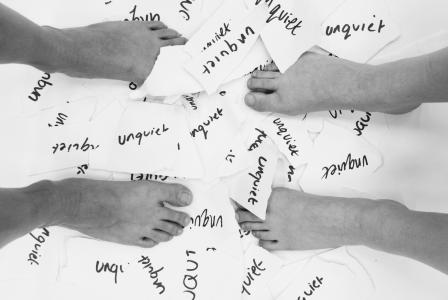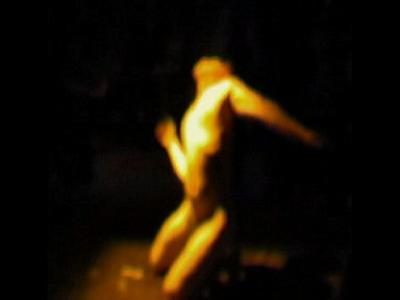Dance Reviews
BUXTON DAY OF DANCE - Chapel-en-le-Frith Morris Men
Around the Town, 24th July
There is neither enough dance nor enough street performance in the Buxton Festival Fringe - all the more reason, therefore, to be grateful to Chapel-en-le-Frith Morris Men for organising this day of dance.
Dancing began at 1030 am and carried on until well after 4pm at the Dome, on Broad Walk, in the Pavilion Gardens, by Turner's Memorial and outside the Opera House.
All told 14 sides danced - mostly from the East Midlands and the North West but special mention should be given to Martlet Sword and Morris Men who travelled from Sussex.
There are those quick to dismiss Morris dancing as bells, sticks and hankies but anyone ready to look and listen for even 15 minutes would have seen that there is much more to it than that.
The hankies and sticks variety is likely to be a version of what is described as Cotswold Morris - as danced by the Chapel Morris Men. Other sides in this tradition came from Adlington and Derby (Chip Off the Old).
If Cotswold Morris seems delicate (though I promise that it is hard work) then the Border Morris of Powderkegs (from Whaley Bridge) is clearly vigorous. With lots of whooping, two saxophones, and vivid costumes they are a shocking sight for some unfamiliar with this aspect of Morris dancing.
Also on offer was clog dancing galore - men from Horwich and the ladies of Milltown Cloggies. There were sword dances from Martlet and Whip the Cat - a Rapper side from Nottingham.
Looking at the programme I managed to miss: Black Dog Molly, Britannia Coco-nut Dancers, Buttercross Belles, Harthill Morris, Manchester Morris Men and Shuttlers Clog. So genuine apologies and thanks to them.
I'm glad it was warm and dry for pretty much all the day. I know that Morris dancers practice most weeks and dance out most weekends over the summer, raising a lot of money for charities. It is hard work and tiring - you won't catch me mocking Morris, only applauding. See you in Buxton next July.
Keith Savage
ENCARNA DANCE PRESENTS UNQUIET - Kerry Allsop and Gemma Collard-Stokes

Unfortunately the sign-posting at Buxton school was very poor which did not make for a good start.
Buxton community school dancers opened the show for Encarna.
First to dance were the summit boys, although full of enthusiasm and energy they could have been a bit tighter, this does not affect their overall performance too much because you could tell these young boys had so much passion and enthusiasm for what they were doing.
The next group were also very good and managed to infuse old jazz and modern jazz together with fantastic transitions between the two. They later braced the stage with a Lady Gaga mash-up, again this group of girls used technique and the transitions between styles and songs were great. I think the best group had to be the second group of boys with their fantastic dancing and also their amazing stunts, whether jumping off walls or climbing up them, they did not fail to impress although I'm not too sure their head teacher would have been.
Buxton community school has some real talent and I shall expect to see a couple of them in professional shows in the future.
Encarna - Ex students of the community school. Their performance was so engaging, though at times the audience did seem confused and slightly lost, their act was mesmerising, their dance broke the rules we associate with dance (talking to the audience). It did however feel more of a a mime or piece of physical theatre. Their piece had a story and the way in which they moved was beautiful, however the story seemed to get a bit lost in translation. I think that Kerry had a much more fluid performance and her connection with the audience was fantastic. The use of coloured paper was excellent, giving it a child like element which matched the rest of the dance. I think the answer to a lot of the questions they had was yes but I did not feel entirely comfortable, I did however enjoy it. Overall it was a good and very different performance.
Katie Collins
SPILTMILK SAY DANCE - Spiltmilk Dance

Underground Venues - Pauper's Pit, remaining performances 17 Jul, 6.30pm, 18, 25 Jul, 1pm.
Fringe Award-winners Spiltmilk have been delighting and surprising Buxton audiences since 2008.
This year's show is a revamped version of last year's with some valuable new touches. Chief among these is their spoken introductions to each new dance. The theme of the show is social dance crazes and we learn about everything from the Twist to Ballroom (a new addition to the show) and Rave to Charleston (also new). The real 'twist' however is that each dance is performed either to no music or to a style of music that has seemingly nothing to do with that particular dance form. Add to this the fact that each dance is broken up into its constituent steps and body movements and you will begin to get an idea how Spiltmilk deconstruct and cleverly subvert everything they touch.
In the past, Spiltmilk have been known to come over a little strict, turning up the lights to make sure the audience reads the programme before each dance. The new spoken introductions, often given whilst performing tricky steps, are much friendlier and certainly added to my understanding. I realised that the apparently inappropriate music was in fact cleverly chosen to reflect the dance style, albeit in an unusual way. Thus after reminding us of the Disco era in which John Travolta types practised their individual moves in front of a mirror, the dancers started doing exactly that to the brilliantly apposite choice of I Did It My Way by Sinatra.
Dancer/choreographers Sarah Devlin, Jenna Hubbard and Adele Wragg are constantly inventive so that even though this is not a new show, there are new elements such as the Ballroom sequence performed against an instructional talk where innocuous lines such as 'I want to quickly review some of the things you should already know' are interpreted through dance in a crazy kind of whole body sign language. There are times too when they choose to speak their dance moves as well as dance them - thus Charleston becomes Flip, Flap, Swish, Bend, in an impossibly intricate sequence which they had off to a tee.
Fun as it all is - and who could forget the Birdy Song performed to Mozart's Eine Kleine Nachtmusik? - there is also something deeply mysterious about Spiltmilk with their Mona Lisa smiles and alien interpretations of dance forms we thought we knew. Happily, they are more than willing to talk about what they do, so please take them up on their invitation to chat to you in the bar after each show.
Stephanie Billen
THREE WORKS - Daniel Somerville

Underground Venues
Daniel Somerville, in a shyly self-deprecating introduction to the second of his Three Works says 'I'm not a dancer. I'm not an actor. I'm not a musician.' There are elements of all three disciplines in these Works, a series of physical meditations that seem almost painfully personal to Somerville.
In the first Work, Somerville's body, from a standing start, becomes gradually more contorted and grotesque; very, very slowly collapsing in a visible pain, his white face a mask of despair, his too-red tongue extended like a lizard. He resembles some kind of newborn, thrust into an alien world. We are told afterwards this piece depicts rejection, and in retrospect this emotion is conveyed expressively.
The second Work, 'First Piano Concerto' concerns loneliness. Daniel stands in the corner, dancing like someone at a party, hoping to make contact but failing. Then as he steps out of his corner, out of his 'comfort zone' (if you'll excuse the cliché), he begins to open himself up, to expose himself both metaphorically and ultimately physically (note to self: the phrase 'neo-burlesque' in the brochure copy is a coded way of saying 'contains nudity') until finally reaching a kind of apotheosis amongst a cloud of bubbles. If anything this piece is a little on the long side, and to some extent spoils the audience for what follows, since by the final piece, I felt I had seen most of what Somerville had to offer physically
Luckily, the final work is perhaps more interesting for its sound-scape, a meditation on Egypt, Aida, his own personal visits to the country and the Egyptian police's purges against, and abuse of, gay men. This aspect of the Work is interesting, personal and educational but the movement is sometimes as amorphous and free-flowing as the smoke which coils in the air like rolling sand dunes.
Daniel Somerville obviously wants the audience to feel connected with him - talking to them personally between the Works, making himself up onstage as they come in, and this aids in humanising these pieces. With a starker, crisper production, the artistry of the performer may have been more obvious, but the prospect might have been more daunting for the audience. In Three Works, Somerville instead conveys a vulnerability and spontaneity that is quite winning.
Robbie Carnegie